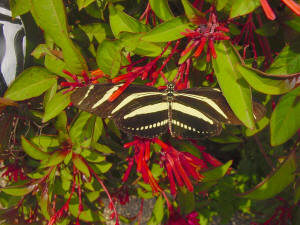 |
FireBush (Hamelia patens)
How about a shrub with an endless supply of orange flowers that hummingbirds adore, butterflies swarm to, foliage that is mostly evergreen with attractive fall color and berries that birds love!
How about a plant that looks great stand-alone, as a focal point, used to hide such uglies as A/C units and pool filters or makes an outstanding hedge!!
Say hello to the Firebush... Sounds too good to be true? It is, but only if you reside north of zone 8. Firebush performs best in warmer climates where it can grow to its full potential 12' x 12'. Winter freezes will nip the shrub requiring severe cut-back therefore reducing the size the following year. Pushing it beyond its "happy zone" and Firebush will die back to the roots. (more on that later) or just plain die.
Firebush is a woody shrub that is easy to grow requiring little if any care on your part. Extremely adaptable to soil types with the exceptions being wet, heavy clay and equally happy in full sun or part sun. I have personally grown Firebush with great success with nary a scoop of fertilizer. Grown in part sun had no effect on flower production but did reduce intensity of fall foliage coloration. Shade grown produces leggy plants with reduced flowering and is not recommended.
Once established this is a very drought tolerant plant and should be considered xeric.
Cloudless Sulfur butterflies are among many species attracted to the numerous orange tube-like flowers which begin blooming in spring. So much so that the plant seems alive with their fluttering wings. Hummingbirds? Plant enough Firebush and you'll never see them on your feeders again!
For those of you in zone 7 all is not lost - you too can enjoy the Firebush but it will never attain the size as it will die back to the roots and hopefully re-emerge in spring!
One of the keys to success in colder climes is buying the largest plant available and planting in spring rather than fall. The larger the plant, the larger the root system. The sooner you get your Firebush in the ground the sooner those roots get growing. The larger the root system at season's end the better able the plant is to survive winter and re-emerge from those roots in spring. None of this matters if you have wet winters - Firebush will require good drainage if that 's the case or elevate by planting atop mounds because they need to be high and dry.
Mulching is the second key to success. Just before first freeze, pile on plenty of pine needles, leaves, straw etc. under the drip line of the plant. Don't be bashful plenty means at least 12-24 inches. I like pine needles closest to the ground followed by leaves/straw with more pine needles on top. What we are trying to do here is to insulate the roots without smothering the plant.
Once the threat of hard-freeze is over, pull back your insulation and the plant usually will usually re-emerge albeit it slowly.
I have never tried to grow Firebush in a container, but that's not to say it can't be enjoyed in this manner and protected accordingly in winter. ... Let me know if you guys have!
Incidentally, there is a dwarf form of Firebush available as well. I have never been overly impressed with it. In comparison its foliage is shinier with more green and not as attractive in the fall. Although bloom is similar, flowers are more yellow. It rarely exceeds 4 ft by 4 ft but may be a great choice for containers in colder climates or those who can't use the large plant!
….